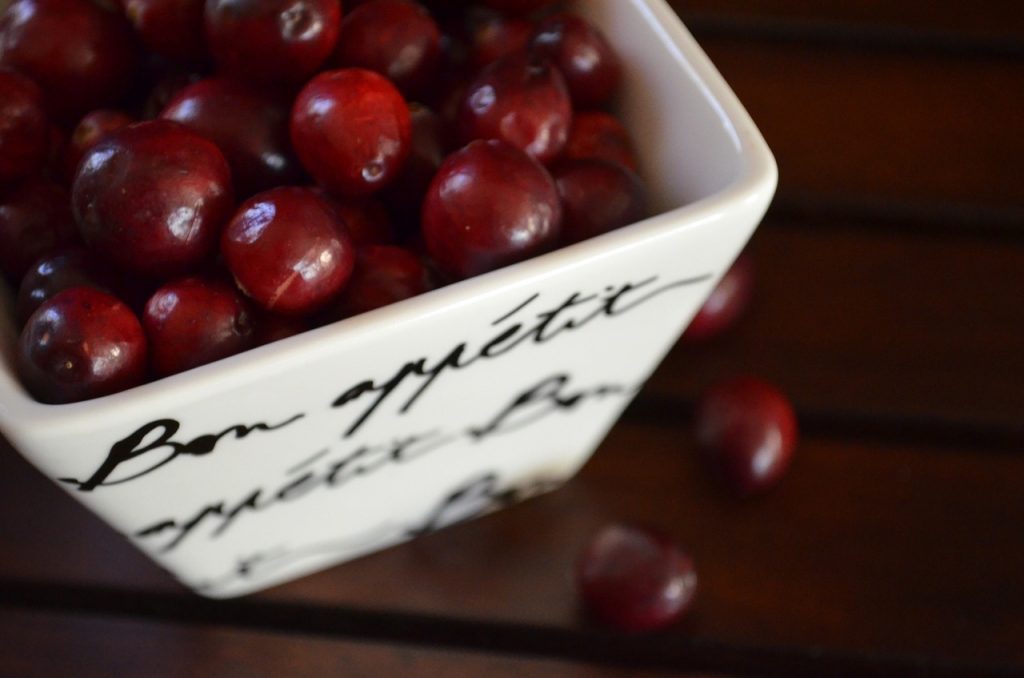The American Cranberry Posted by Gary Locke on Nov 17, 2017 in Culture
Consider the cranberry. Grown primarily in North America, the cranberry, with its vibrant ruby color, is the festive, decorative heart of the Thanksgiving table. Many, if not most, American homes will have some representation of the cranberry present during the final six weeks of the year. Despite its high acidity, it will be consumed by millions as part of a pie, cake, bread, or sauce. While only about 5% of all harvested cranberries are sold as fresh berries, it is nevertheless the American berry.
They contain moderate levels of vitamin C, a significant amount of manganese, and some dietary fiber. As a juice or extract, it is often consumed by women with urinary tract infections, although a 2012 study calls this practice into question. It is also sometimes called a superfruit, because of its perceived health benefits, which may be somewhat overstated. Cranberry juice, which is a popular drink, has a high sugar content. Some studies have linked its consumption to obesity.
Cranberry History
Cranberries are harvested in wetland areas, called bogs, carved out by glaciers thousands of years ago. They grow along vines, like the strawberry, laid out across these bogs which are rich in organic deposits, including sand which was blown into the bogs across many miles. Because they float, cranberry bogs are flooded with water in the fall to make the harvesting of the berries easier.
We get the name of the fruit from the European settlers, who called it the crane berry because they thought that the blossom on the vine looked like the head of the sandhill crane (which also ate the berry when ripe). The Algonquin tribe of Wisconsin, where most cranberries in the US are harvested, called the fruit atoqua. They did not spend much time cultivating the berry, but they would gather the berries for use in making pemmican, a kind of dried meat like a jerky. It also was used as an effective dye for blankets and clothing. They were also the first to combine the berry with maple syrup to make a sweet/tart sauce.
Historians agree that the cranberry was almost certainly on the first Thanksgiving table. In 1621, the settlers of Plymouth colony in Massachusetts sat down to dine with the Wampanoag tribe to celebrate the colonists’ first successful autumn harvest. However, since the berry was tart, and native Americans rarely ate the cranberry, exactly how significant the berry was to the feast is a source of some dispute. Again, it is possible that it was combined with sugar or maple syrup to make a sauce. But, sugar was a precious commodity to the settlers, and native Americans rarely shared their supply of maple syrup. The berries may have instead been nibbled on as they ate to offset the other, rich flavors of the meal. They may simply have been a table decoration.
Something to Relish
We don’t have any written record of a cranberry sauce until the late 18th century, when the American Cookery book by Amelia Simmons was first published, calling for boiled onions and cranberry sauce to be served at the harvest table alongside fowl. It is reasonable to assume, then, that the tradition of a Thanksgiving cranberry relish, served much like a British chutney, had existed for some years. In 1864, during the American Civil War, General Grant issued a proclamation that Union soldiers were to be served cranberry relish for their Thanksgiving meal.
Then there’s the jelly.
Because of the very nature of the cranberry, it bruises easily. Modern methods of harvesting the fruit increase the likelihood of many berries being bruised as they are raked and pulled from their vines. While most people would like to see pretty, pristine berries on their table, what is to become of the many berries with brown spots?
The answer was to precook, then can the cranberry sauce. This eliminated the problem of consumers looking at unsightly berries. What wasn’t expected was the natural pectin in the sauce, creating a jelled product as it sits in the can. The popular Ocean Spray cranberry sauce can is ribbed. When the can is opened, and the jelly is carefully removed, those ribs add a kind of decorative element to the final log on the table. Many a homemaker in the 20th century looked for ways to dress up their cranberry jelly!
But, for me, the true joy of cranberry relish is perfecting my own recipe. It gets tinkered with every year. Here is my latest. Enjoy!
Cranberry Relish
- ½ cup tangerine juice
- ½ cup superfine sugar
- ¼ cup light brown sugar
- 12 oz. cranberries
- Zest of two tangerines or clementines
- ¼ cup chopped crystallized ginger
- ¼ teaspoon of allspice
- Pinch of cinnamon
- 4 oz. of Cointreau
In a medium saucepan, over medium heat, dissolve the sugars in the tangerine juice.
Whisk in the zest, ginger, and spices.
Add the whole cranberries, stir to coat them, then lower heat to a simmer.
Continue to simmer for 15/20 minutes, until most of the cranberries have popped and the mixture has thickened.
Remove from heat, then add the Cointreau and stir. It will now begin to gelatinize. Let the mixture slowly cool to room temperature before removing from the pan, and spoon into a serving bowl.

Build vocabulary, practice pronunciation, and more with Transparent Language Online. Available anytime, anywhere, on any device.




